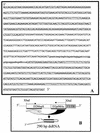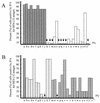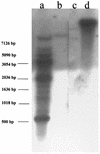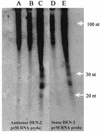RNA silencing of dengue virus type 2 replication in transformed C6/36 mosquito cells transcribing an inverted-repeat RNA derived from the virus genome
- PMID: 12438618
- PMCID: PMC136701
- DOI: 10.1128/jvi.76.24.12925-12933.2002
RNA silencing of dengue virus type 2 replication in transformed C6/36 mosquito cells transcribing an inverted-repeat RNA derived from the virus genome
Abstract
Double-stranded RNA (dsRNA) initiates cellular posttranscriptional responses that are collectively called RNA silencing in a number of different organisms, including plants, nematodes, and fruit flies. In plants, RNA silencing has been associated with protection from virus infection. In this study, we demonstrate that dsRNA-mediated interference also can act as a viral defense mechanism in mosquito cells. C6/36 (Aedes albopictus) cells were stably transformed with a plasmid designed to transcribe an inverted-repeat RNA (irRNA) derived from the genome of dengue virus type 2 (DEN-2) capable of forming dsRNA. Clonal cell lines were selected with an antibiotic resistance marker and challenged with DEN-2. The cell lines were classified as either susceptible or resistant to virus replication, based on the percentage of cells expressing DEN-2 envelope (E) antigen 7 days after challenge. Eight out of 18 (44%) cell lines designed to express irRNA were resistant to DEN-2 challenge, with more than 95% of the cells showing no DEN-2 antigen accumulation. One of the DEN-2-resistant cell lines, FB 9.1, was further characterized. DEN-2 genome RNA failed to accumulate in FB 9.1 cells after challenge. Northern blot hybridization detected transcripts containing transgene sequences of both sense and antisense polarity, suggesting that DEN-2-specific dsRNA was present in the cells. In addition, a class of small RNAs 21 to 25 nucleotides in length was detected that specifically hybridized to labeled sense or antisense DEN-2 RNA derived from the target region of the genome. These observations were consistent with RNA silencing as the mechanism of resistance to DEN-2 in transformed mosquito cells.
Figures








References
-
- Adelman, Z. N., C. D. Blair, J. O. Carlson, B. J. Beaty, and K. E. Olson. 2001. Sindbis virus-induced silencing of dengue viruses in mosquitoes. Insect Mol. Biol. 10:265-273. - PubMed
-
- Bernstein, E., A. A. Caudy, S. M. Hammond, and G. J. Hannon. 2001. Role for a bidentate ribonuclease in the initiation step of RNA interference. Nature 409:363-366. - PubMed
-
- Caplen, N. J., Z. Zheng, B. Falgout, and R. A. Morgan. 2002. Inhibition of viral gene expression and replication in mosquito cells by dsRNA-triggered RNA interference. Mol. Ther. 6:243-251. - PubMed
-
- Carlson, J. O., K. E. Olson, S. Higgs, and B. J. Beaty. 1995. Molecular manipulation of mosquitoes. Annu. Rev. Entomol. 40:359-388. - PubMed
Publication types
MeSH terms
Substances
Grants and funding
LinkOut - more resources
Full Text Sources
Other Literature Sources
Medical

